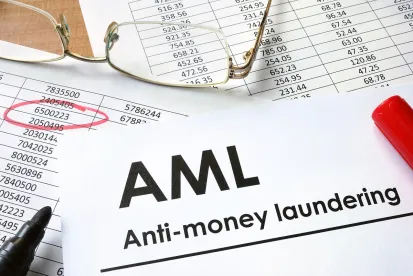On June 6, 2022, the Financial Crimes Enforcement Network (“FinCEN”), a bureau of the U.S. Department of the Treasury, issued an Advanced Notice of Proposed Rulemaking (“ANPRM”), requesting public comment on questions related to FinCEN’s implementation of a no-action letter process.[1] The ANPRM seeks to determine whether the public supports the no-action letter process and how the public expects the process to differ from other forms of relief that FinCEN already offers.
FinCEN’s Report to Congress
FinCEN began considering a no-action letter process after the passage of the Anti-Money Laundering Act of 2020 (the “AML Act”). Section 6305(a) of the AML Act required FinCEN to assess whether it should establish a process for issuing no-action letters in response to inquiries from persons concerning the application of anti-money laundering or countering the financing of terrorism laws (such as the Bank Secrecy Act, the USA PATRIOT Act, and section 8(s) of the Federal Deposit Insurance Act) and regulations to a regulated entity’s specific conduct.[2] Section 6305(b) of the AML Act required FinCEN to submit a report (the “Report”) to Congress, which contains all findings and determinations made in carrying out the no-action letter assessment as well as proposed rulemakings, if appropriate, to implement the findings and determinations the agency made throughout the no-action letter assessment process.
On June 28, 2021, FinCEN submitted the Report to the Committee on Banking, Housing, and Urban Affairs of the Senate and to the Committee on Financial Services of the House of Representatives, concluding that the agency “should undertake a rulemaking in order to establish a no-action letter process to supplement the existing forms of regulatory guidance and relief that may currently be requested.”[3] FinCEN also noted that that a no-action letter process would be most effective “if it is limited to FinCEN’s exercise of its own enforcement authority, as opposed to also addressing other regulators’ exercise of their distinct enforcement authorities.”[4]
In addition, the Report included a proposed timeline for FinCEN’s response to no-action letter requests, which could be as short as 90 to 120 days for relatively simple matters, or much longer for more complex matters. The Report also included an analysis of whether improvements to current processes are necessary. Generally, FinCEN identified four ways it could improve its current processes, which include: (i) publicly and clearly identifying mechanisms for regulatory guidance and relief; (ii) having more meaningful consultations with other regulators; (iii) obtaining more staff and resources; and (iv) having better dialogue between itself and its regulated entities. Further, the Report assessed whether the no-action letter process would mitigate or accentuate illicit finance risks in the United States and identified several areas in which a no-action letter process would potentially mitigate or accentuate such risk.
Cross-Regulator No-Action Letter Process
Furthermore, Section 6305 of the AML Act contemplates the possibility of a no-action letter process that would allow a no-action letter issued by FinCEN to apply to other regulators, which would “address[] the various agencies’ respective enforcement authorities.”[5] The Report found that this “cross-regulator no-action letter” process would potentially bind multiple agencies’ respective enforcement authorities, and that FinCEN had “found no other instance of a process where one regulator provides a no-action letter with respect to another regulator’s enforcement authority.”[6] After consulting with several other regulatory agencies, FinCEN determined that the cross-regulator process was unfeasible because it would present legal and practical challenges. Although FinCEN determined the viability of a cross-regulator no-action letter process is unlikely, the ANPRM leaves the door open for the public to comment on certain questions related to this process. For example, one of the questions FinCEN asks is whether “there [are] additional points FinCEN should consider in assessing the viability of a cross-regulator no-action letter process?”
Existing Methods of Relief
One of FinCEN’s goals with the ANPRM is to identify how its existing forms of regulatory guidance and relief might supplement or overlap with a potential no-action letter process. FinCEN currently uses two forms of regulatory guidance or relief: (1) administrative rulings and (2) exceptive or exemptive relief. An administrative ruling shall bind FinCEN only in the event that the request describes a specifically identified actual situation. FinCEN’s administrative rulings may have precedential value, but only if FinCEN publishes the ruling on its website or another appropriate forum.[7] FinCEN’s exceptive or exemptive relief offers either an exception to or an exemption from FinCEN’s regulations.[8] These exceptions and exemptions are revocable by the Secretary of the Treasury.
While FinCEN does not yet use no-action letters, some other regulators do, such as the Securities and Exchange Commission, the Commodity Futures Trading Commission, and the Consumer Financial Protection Bureau. In contrast to the above relief methods, these regulators’ letters indicate the regulators’ intention to not take or recommend enforcement action against a submitting party’s specific conduct as set out in that party’s request.[9]
ANPRM’s Questions
Overall, FinCEN’s ANPRM contains forty-eight questions for public comment. While the first forty-four questions deal chiefly with the proposed no-action letter process, the last four deal with the process’s potential interaction with existing methods of relief. Specifically, the questions are arranged into various categories, which include: additional considerations relating to the Report; the contours and format of a FinCEN no-action letter process; FinCEN jurisdiction; changed circumstances; revocation; no-action letter denials and withdrawals; confidentiality; consultation with other agencies, and other questions. Below, we provide a general summary of the questions presented in each category.
-
Additional Considerations Relating to the Report—this section asks for input on issues covered by the Report, and on issues that may have been overlooked. FinCEN wants to know whether the public considers a no-action letter process useful.
-
Contours and Format of a FinCEN No-Action Letter Process—this section asks for input on the scope of the process, what procedural or filing requirements should exist, and other mechanical aspects.
-
FinCEN Jurisdiction and No-Action Letters—this section asks when FinCEN should determine if it has jurisdiction for a particular request, and also covers the outer limits of its jurisdiction.
-
Changed Circumstances—this section asks what should happen if the requesting organization restructures, FinCEN wishes to change its position from a prior letter, or if the law or regulations change after FinCEN’s letter is issued.
-
Revocation—this section asks what rules should govern potential revocation or expirations of letters.
-
No-Action Letter Denials and Withdrawals—this section asks whether FinCEN should create an appeals process for denied requests, whether denials should be published, and whether the requester may withdraw their request.
-
Confidentiality—this section asks what level of confidentiality should be expected during and after the process.
-
Consultation—this section asks what procedure and considerations should FinCEN use to consult with other regulators. It also asks whether a requester should be required to identify all of its regulators and whether other circumstances exist where information obtained from the process should be shared with other regulators.
-
Other Questions—this section asks what types of burdens regulated entities might expect from the process, and what topics might be generated in the process. It also asks for any other comments that would be helpful in developing the process.
Conclusion
The ANPRM offers stakeholders the opportunity to provide input on all aspects of the implementation of a no-action letter process, in addition to the specific questions FinCEN posed. Written comments on the ANPRM must be received on or before August 5, 2022.
Thanks to our Summer Associate, Apollo Yong, for his work on this timely blog.
ENDNOTES
[1] No-Action Letter Process, 87 Fed. Reg. 34224 (proposed June 6, 2022) (to be codified at 31 C.F.R. pt. 1010). “A ‘no-action letter’ is generally understood to be a form of an exercise of enforcement discretion wherein an agency issues a letter indicating its intention not to take enforcement action against the submitting party for the specific conduct presented to the agency.” See FinCEN, A Report to Congress: Assessment of No-Action Letters in Accordance with Section 6305 of the Anti-Money Laundering Act of 2020 (2021), https://www.fincen.gov/sites/default/files/shared/No-Action%20Letter%20Report%20to%20Congress%20per%20AMLA%20for%20ExecSec%20Clearance%20508.pdf.
[2] FinCEN, supra note 1.
[3] Id. at 1.
[4] Id.
[5] Id. at 5.
[6] Id. (“Such a process would therefore appear to be unprecedented.”).
[7] 31 C.F.R § 1010.715.
[8] 31 U.S.C. § 5318(a)(7); 31 C.F.R § 1010.970.
[9] Cf., e.g., 17 C.F.R § 140.99; 17 C.F.R § 200.81(a); Policy on No-Action Letters, 84 Fed. Reg. 48229 (Sept. 13, 2019) (to be codified at 12 C.F.R. ch. X); id. at 48244.




 />i
/>i

